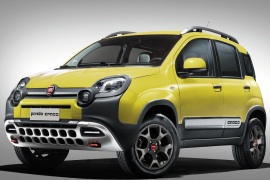FIAT Panda Cross Models/Series Timeline, Specifications & Photos
First production year: 2014
Engines: Gasoline, Diesel
Body style: SUV (Sports Utility Vehicle)
Fiat introduced a new version of its small-sized crossover Panda 4x4 in 2014, adding more rugged elements to the vehicle and making it more off-road capable.
The Italian automaker offered a 4x4 version of the Panda on the first generation in 1983, and owners loved it. Thus, Fiat helped Italians and many other European customers to enjoy a day at a picnic without the fear of getting stuck on some fields or at a campsite. The idea was carried over to the third generation of this nameplate. But the look didn't exactly match the car's possibilities. So Italians made it look even tougher and renamed it Panda Cross.
At the front, the car boasted a new bumper fitted with a large skid plate at the bottom to protect the engine and transmission and flanked it with unpainted plastic elements. Above them, the headlights, fog lamps, and LED daytime running lights were well protected against grass and bushes. But Fiat didn't stop there and added additional protection on the lower side of the doors and the side sills. Combined with a high ground clearance of 16 cm (6.3 inches) and 185/65R15 tires (larger than on the Panda 4x4), the Cross showed more muscle for an off-road trip. Finally, at the back, another underbody shield protected the rear bumper from scratches and hits.
Inside, the automaker didn't make too many changes but worked on those that mattered most. Thus, the front seats boasted brown eco-leather bolstered areas that matched the door cards' trims. In addition, the seatbacks were adorned with the "Cross" wording embroidered. Fiat added a new copper color on the dashboard and the center consoleand satin titanium finish.
Although not a hard-core off-road machine, the Panda Cross featured an all-wheel drive system with electronic controls for the center differential. Furthermore, the 24° (approach), 33° (departure), 20° (ramp break over) angles, and 31.5° (70%) climb gradient allowed it to perform far better than many other heavier crossovers.
